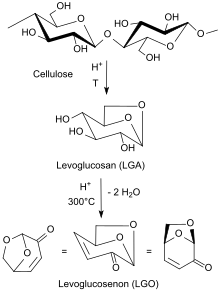Levoglucosenone
Levoglucosenone is a bridged, unsaturated heterocyclic ketone formed from levoglucosan by loss of two molecules of water. It is the major component produced during the acid-catalysed pyrolysis of cellulose, D-glucose, and levoglucosan.[2]
 | |
| Names | |
|---|---|
| IUPAC name
(1S,5R)-6,8-Dioxabicyclo[3.2.1]oct-2-en-4-one | |
| Identifiers | |
3D model (JSmol) |
|
| ChEBI | |
| ChemSpider | |
PubChem CID |
|
| UNII | |
CompTox Dashboard (EPA) |
|
| |
| |
| Properties | |
| C6H6O3 | |
| Molar mass | 126.111 g·mol−1 |
| Density | 1.304 g/cm3 (20 °C) [1] |
| Boiling point | 231 °C; 448 °F; 504 K [1] |
| Vapor pressure | 6.2 Pa (25 °C) [1] |
Refractive index (nD) |
1.5065 (20 °C)[1] |
Except where otherwise noted, data are given for materials in their standard state (at 25 °C [77 °F], 100 kPa). | |
| Infobox references | |
History
The compound was first identified in 1970 as a product of the thermal decomposition of cellulose.[3]
Production

The primary way of obtaining levoglucosenone is via pyrolysis of carbohydrates, particularly cellulose. Levoglucosenone can be derived from biomass or from other cellulosic materials including domestic/commercial waste paper. The availability of multiple sources is a key advantage when compared to other platform chemicals which are solely derived from biomass.
Selectivity can be improved using an acid catalyst, such as phosphoric acid. Zeolites and solid superacids can also be used, as well as ionic liquids. A sample of microcrystalline cellulose is first pretreated with catalytic amounts of an acid, such as phosphoric acid, and then heated to 270-300°C, affording a bio-oil. Alongside levoglucosenone as a major product, 2-furfuraldehyde is also formed in significant quantities as an impurity at 5-10%. The bio-oil can be vacuum distilled, resulting in purified levoglucosenone.[4]
The use of polar, aprotic solvents such as THF, γ-valerolactone and sulfolane has been found to improve pyrolytic yields, as the solvents cause swelling of the cellulose and inhibit repolymerisation back to levoglucosan. These solvents also promote catalytic dehydration of levoglucosan to levoglucosenone.[5]
Microwave irradiation of microcrystalline cellulose can also be used to produce levoglucosenone.[6]
Uses
As a highly functionalized, chiral compound, levoglucosenone has uses as a building block in organic synthesis to produce a wide variety of natural and non-natural compounds.[7] Recently, the Australian company Circa developed the Furacell™ technology, a continuous process to convert a wide range of cellulosic biomass into levoglucosenone. From then on, levoglucosenone has been considered a promising bio-renewable platform for the production of commodity chemicals, being especially interesting the new insight provided by Huber and co-workers into how to transform this molecule into α,ω-diols, monomers for the production of polyesters and polyurethanes.[8]
Nowadays, the spotlight is on the use of heterogeneous catalysts to yield hydrogenation and hydrogenolysis derived products. In this sense, Pd supported on carbon, alumina, and silica-alumina can be used to obtain a variety of products via hydrogenation (i.e. dihydrolevoglucosenone and levoglucosanol), and hydrogenolysis (i.e. tetrahydrofurandimethanol (THFDM) and 1,6-hexanediol), tuning the selectivity by simply changing reaction conditions.[9] More recently, Pd and Pt supported on zirconium oxide proved to be efficient catalysts to obtain either dihydrolevoglucosenone or levoglucosanol, respectively, under mild reaction conditions, taking advantage of the different selectivity of these metals towards the hydrogenation of specific functional features.[10]
See also
References
- Baird, Zachariah Steven; Uusi-Kyyny, Petri; Pokki, Juha-Pekka; Pedegert, Emilie; Alopaeus, Ville (6 Nov 2019). "Vapor Pressures, Densities, and PC-SAFT Parameters for 11 Bio-compounds". International Journal of Thermophysics. 40 (11): 102. doi:10.1007/s10765-019-2570-9.
- Halpern, Y.; Riffer, R.; Broido, A. (1973). "Levoglucosenone (1,6-anhydro-3,4-dideoxy-.DELTA.3-.beta.-D-pyranosen-2-one). Major product of the acid-catalyzed pyrolysis of cellulose and related carbohydrates". The Journal of Organic Chemistry. 38 (2): 204–209. doi:10.1021/jo00942a005. ISSN 0022-3263.
- Tsuchiya, Yoshio; Sumi, Kikuo (1970). "Thermal decomposition products of cellulose". Journal of Applied Polymer Science. 14 (8): 2003–2013. doi:10.1002/app.1970.070140808. ISSN 0021-8995.
- Comba, María B.; Tsai, Yi-hsuan; Sarotti, Ariel M.; Mangione, María I.; Suárez, Alejandra G.; Spanevello, Rolando A. (2017-12-19). "Levoglucosenone and Its New Applications: Valorization of Cellulose Residues". European Journal of Organic Chemistry. 2018 (5): 590–604. doi:10.1002/ejoc.201701227. ISSN 1434-193X.
- Kudo, Shinji; Goto, Nozomi; Sperry, Jonathan; Norinaga, Koyo; Hayashi, Jun-ichiro (2016-12-21). "Production of Levoglucosenone and Dihydrolevoglucosenone by Catalytic Reforming of Volatiles from Cellulose Pyrolysis Using Supported Ionic Liquid Phase". ACS Sustainable Chemistry & Engineering. 5 (1): 1132–1140. doi:10.1021/acssuschemeng.6b02463. ISSN 2168-0485.
- Sarotti, Ariel M.; Spanevello, Rolando A.; Suárez, Alejandra G. (2007). "An efficient microwave-assisted green transformation of cellulose into levoglucosenone. Advantages of the use of an experimental design approach". Green Chemistry. 9 (10): 1137. doi:10.1039/b703690f. ISSN 1463-9262.
- Sarotti, Ariel M.; Zanardi, María M.; Spanevello, Rolando A.; Suárez, Alejandra G. (2012-11-01). "Recent applications of levoglucosenone as chiral synthon". Current Organic Synthesis. 9 (4): 439–459. doi:10.2174/157017912802651401.
- Huber, George W.; Dumesic, James A.; Hermans, Ive; Maravelias, Christos T.; Banholzer, Williams F.; Walker, Theodore; Burt, Samuel P.; Brentzel, Zachary J.; Alonso, David M. (2017-09-20). "New catalytic strategies for α,ω-diols production from lignocellulosic biomass". Faraday Discussions. 202: 247–267. doi:10.1039/C7FD00036G. ISSN 1364-5498. PMID 28678237.
- Krishna, Siddarth H.; McClelland, Daniel J.; Rashke, Quinn A.; Dumesic, James A.; Huber, George W. (2016-12-12). "Hydrogenation of levoglucosenone to renewable chemicals". Green Chemistry. 19 (5): 1278–1285. doi:10.1039/C6GC03028A.
- Mazarío, Jaime; Parreño Romero, Míriam; Concepción, Patricia; Chávez-Sifontes, Marvin; Spanevello, Rolando A.; Comba, María B.; Suárez, Alejandra G.; Domine, Marcelo E. (2019-07-26). "Tuning zirconia-supported metal catalysts for selective one-step hydrogenation of levoglucosenone". Green Chemistry. 21 (17): 4769–4785. doi:10.1039/C9GC01857C. ISSN 1463-9270.